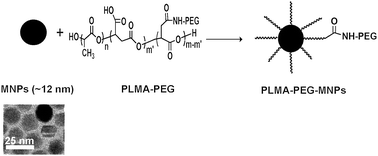Magnetic nanoparticles for magnetic resonance imaging: modulation of macrophage uptake by controlled PEGylation of the surface coating†
Abstract
Magnetic

* Corresponding authors
a
Department of Chemical and Biomolecular Engineering, National University of Singapore, Kent Ridge, Singapore
E-mail:
chenkg@nus.edu.sg
Fax: +65 67791936
Tel: +65 65162176
b Department of Diagnostic Radiology, National University of Singapore, Kent Ridge, Singapore
Magnetic

 Please wait while we load your content...
Something went wrong. Try again?
Please wait while we load your content...
Something went wrong. Try again?
C. Huang, K. G. Neoh, L. Wang, E. Kang and B. Shuter, J. Mater. Chem., 2010, 20, 8512 DOI: 10.1039/C0JM01526A
To request permission to reproduce material from this article, please go to the Copyright Clearance Center request page.
If you are an author contributing to an RSC publication, you do not need to request permission provided correct acknowledgement is given.
If you are the author of this article, you do not need to request permission to reproduce figures and diagrams provided correct acknowledgement is given. If you want to reproduce the whole article in a third-party publication (excluding your thesis/dissertation for which permission is not required) please go to the Copyright Clearance Center request page.
Read more about how to correctly acknowledge RSC content.
 Fetching data from CrossRef.
Fetching data from CrossRef.
This may take some time to load.
Loading related content
